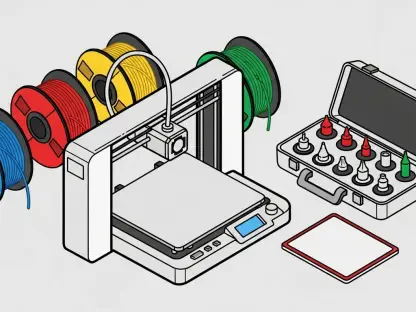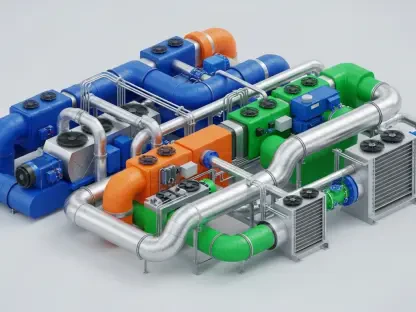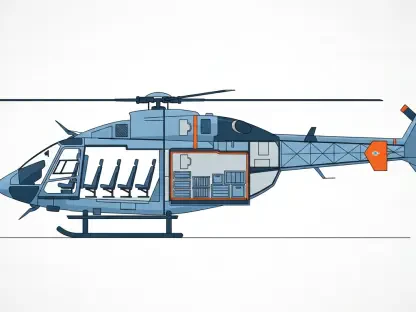In the evolving landscape of military technology, a groundbreaking advancement is poised to redefine the parameters of combat training. Flexible, wearable electronic textiles, or e-textiles, have emerged as a revolutionary tool in monitoring and optimizing soldiers’ training regimens. These e-textiles utilize advanced 3D printing techniques and innovative materials to integrate sensors directly into combat uniforms, making them an indispensable asset for military personnel. By capturing precise movement data and physiological parameters, this technology offers tailored training solutions that address the unique needs of individual combatants, thus enhancing training effectiveness.
The Role of Direct Ink Writing in E-Textile Development
Advanced Integration Techniques
A critical innovation in the development of e-textiles is Direct Ink Writing (DIW) 3D printing technology. This technique enables the direct application of electronic circuits onto fabric surfaces, departing from traditional e-textile fabrication methods that often involve more complex steps and offer limited customization. In DIW, conductive inks are deposited onto textile substrates, creating customizable patterns without requiring additional steps like mask fabrication. The simplicity and flexibility of this method not only streamline the production process but also allow for scalability and cost-effectiveness, essential for mass deployment in the military.
The utility of DIW 3D printing lies in its ability to precisely manage the deposition of conductive inks, creating robust circuits that can endure the physical demands of military activities. This innovative process opens new possibilities for customizing military wearables, making them capable of real-time data collection and analysis. By embedding sensors and circuits directly into combat uniforms, soldiers gain access to intuitive and responsive training aids that can adapt to a wide range of exercises and combat scenarios, ensuring high reliability under various conditions.
Functional Inks and Their Importance
The cornerstone of e-textile technology is the development of advanced functional inks that combine flexibility with electrical conductivity. These inks are engineered from specialized materials including a styrene-butadiene-styrene (SBS) polymer for elasticity and multi-walled carbon nanotubes (MWCNT) for conductivity. This combination produces inks capable of withstanding extensive physical stress, ensuring uninterrupted performance during intense training exercises. The SBS polymer allows the ink to stretch significantly, while the MWCNT provides the necessary pathways for electrical signals, making it pivotal for sensor functionality.
Additionally, the creation of innovative electrode inks enhances the connectivity between various textile layers, supporting the development of multilayered wearable systems. These electrodes, composed of materials like silver flakes and polystyrene, are strategically formulated to penetrate fabrics effectively, ensuring consistent electrical connections. The ability to achieve reliable signal transmission across multiple textile layers is crucial in capturing detailed and diverse data. This advancement not only supports the primary motion-sensing function of the e-textiles but also expands their capabilities into other applications, making them versatile tools in comprehensive performance monitoring.
Practical Applications and Validation of E-Textiles
Motion Detection and Real-Time Feedback
The functionality of the e-textile platform has been rigorously validated through experimental studies, focusing on its ability to detect real-time movement and provide instantaneous feedback. Sensors were strategically printed on areas such as the shoulders, elbows, and knees, which are critical for monitoring dynamic activities like running, jumping jacks, and push-ups. These tests demonstrated the platform’s ability to accurately capture and analyze movement patterns, offering detailed insights into a soldier’s physical performance. The real-time feedback ensures that training sessions can be adjusted on the fly, optimizing each exercise for maximum effectiveness based on individual dynamics.
The e-textile’s potential extends beyond traditional motion detection as it enables detailed posture analysis, offering new opportunities for refining combat techniques. By evaluating posture and movement nuances, the technology can guide soldiers in perfecting their form, which is vital for preventing injuries and improving performance. This real-time analytical capability fosters a more responsive training environment where soldiers can continually refine their techniques in line with their unique physicality and training goals, demonstrating a significant step forward in precision military training.
Expanding Capabilities Beyond Motion Tracking
Beyond its primary function of motion tracking, the adaptability of e-textiles is illustrated through potential applications in various domains. For instance, smart masks equipped with this technology allow for detailed respiratory monitoring, providing vital data during rigorous training or combat scenarios. Similarly, by integrating them into gloves, e-textiles can offer tactile recognition features, enhancing capability through sensors that detect pressure and movement. Through such innovations, the e-textile platform could extend its influence into broader occupational settings, equipping users with vital performance insights across varied tasks.
These extended applications highlight the versatility of e-textiles as they begin to navigate areas beyond standard military training, demonstrating significant potential for cross-industry deployment. From monitoring environmental conditions to enhancing communication systems, the ability to assimilate multiple sensors into wearable formats means e-textiles can address diverse challenges within and beyond the military sector. This adaptability underscores their value as a future-proof solution capable of transforming traditional methodologies and introducing a new level of technological sophistication into conventional approaches.
Impact on Military Readiness and Strategic Advantages
Enhancements in Combat Readiness
The strategic integration of e-textiles into military training regimens holds substantial promise for augmenting combat readiness. As demonstrated in research involving Major Kyusoon Pak of the Army, these technologies are poised to underpin a new era of military training where data-driven insights are central to preparing soldiers more efficiently. Tailored training solutions driven by e-textiles ensure that soldiers not only meet the physical requirements of their roles but also enhance their survivability on the battlefield, essential in the context of demographic changes that impact military workforce numbers.
Furthermore, by focusing on individual performance metrics, e-textiles contribute significantly to optimizing resource allocation within training programs. The data garnered from e-textile systems allows military decision-makers to tailor training strategies, ensuring resources are devoted to areas that yield the most significant improvements in preparedness and performance. This targeted approach maximizes training outcomes and aligns with broader defense objectives aimed at maintaining high efficacy across all operational levels while balancing economic considerations.
Bridging Academic and Practical Innovations
The research underpinning the development of these sophisticated e-textiles highlights the powerful intersection between academic innovation and practical military applications. By leveraging advancements in nanotechnology and materials science, researchers have forged a robust platform that not only advances scientific understanding but also directly addresses contemporary military challenges. The collaboration between academia and the military exemplifies a successful model for integrating cutting-edge technologies into real-world applications, underscoring the value of interdisciplinary partnerships.
This synthesis of technology and military strategy paves the way for continued innovation in defense capabilities. By fostering an environment conducive to academic contributions and practical solutions, the integration of e-textiles serves as a beacon for future collaborative endeavors. Such partnerships are crucial for maintaining a competitive edge in rapidly developing technological landscapes, ensuring the military remains equipped to meet emerging threats and challenges through the adoption of innovative solutions.
Moving Forward: Implications and Future Directions
In the rapidly advancing world of military technology, a significant breakthrough is set to reshape how combat training is conducted. This innovation comes in the form of flexible, wearable electronic textiles, known as e-textiles, which have emerged as a cutting-edge tool for tracking and enhancing soldiers’ training programs. Utilizing state-of-the-art 3D printing techniques along with advanced materials, these e-textiles embed sensors directly into military uniforms. This integration transforms them into crucial assets for soldiers, allowing for precise monitoring of movements and the collection of vital physiological data. As a result, these textiles offer customized training solutions catering to the specific needs of individual soldiers, ultimately boosting the effectiveness of their training programs. This level of personalization not only improves the performance of individual combatants but also enhances the preparedness and efficiency of military units as a whole, showcasing the profound impact of technology in modern warfare contexts.









